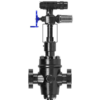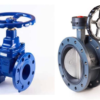You can contact us 24/7 +1(239) 355-5809
What Is a Cameron Type FLS Hydraulic Gate Valve and Why It’s Important for Frac Operations
In the high-stress, high-pressure environment of hydraulic fracturing operations, safety and equipment reliability are of the utmost importance. One of the key components that provide operational integrity in such unfavorable processes is the Cameron Type FLS Hydraulic Gate Valve. It is now standard equipment in frac operations today, supplying essential flow control capability in extremely high-pressure applications.
Understanding the Cameron Type FLS Hydraulic Gate Valve
Cameron Type FLS (Fracturing Line Service) Hydraulic Gate Valve is a heavy-duty flow control valve tailored to hydraulic fracturing service requirements. Cameron, an oilfield equipment company founded decades ago that is now owned by Schlumberger, designs these valves with the harsh operating conditions found while frac-ing operations.
Key Design Features
The FLS valve incorporates many design features that are well-suited to frac operations:
- Solid Gate Design: Unlike standard gate valves which may use a split gate, the FLS valve utilizes a solid slab gate that provides higher strength and pressure sealing capability.
- Hydraulic Actuation: Hydraulically actuated by pressure, the valve provides remote operation for maintaining personnel at a distance from high-pressure areas for safe critical operations.
- Bidirectional Sealing: The FLS valve offers dependable sealing in both directions, a necessity when working with unstable pressures typical of frac operations.
- Heavy-Duty Construction: Made of high-strength materials and with special heat treatment procedures, these valves are able to endure the abrasive slurries and high pressures associated with fracturing.
- Extended Pressure Ratings: Usually rated for operating pressures as high as 15,000 psi (and even more), these valves provide for the high pressures necessary for efficient formation fracturing.
- Fast Operation: While built to be rugged, FLS valves are engineered to function quickly, enabling fast reaction to a change in operating conditions or to an emergency.
Critical Applications in Frac Operations
Primary Isolation and Control
In fracturing operations, the FLS valve is often the primary isolation point between the wellhead and the high-pressure pumps. This valve position must be totally reliable, as failure of the valve would have catastrophic consequences such as:
- Uncontrolled release of high-pressure fluid
- Loss of costly equipment
- Possible environmental accidents
- Risk to personal security
Manifold Systems Integration
FLS valves play a critical role in frac manifolds, the intricate network of piping and valves that manages the flow of fracturing fluids. Within these systems, the valves serve numerous functions:
- Guiding frac fluid to individual wellheads in multi-well pad operations
- Isolating individual flow lines for maintenance or upon failure
- Providing emergency shut-in capacity
- Allowing pressure testing of lines before operations are in progress
Blowout Prevention
Although not a replacement for blowout preventers (BOPs) as such, FLS valves offer an additional safety layer in the pressure control system. Their capacity for fast action and high-pressure sealing qualify them as valuable members of the overall safety system.
Why the Cameron FLS Valve Stands Out
Pressure Handling Capability
The most obvious advantage of the Cameron FLS valve is that it can handle the high pressures of today’s fracturing operations. As formations become more challenging and demand higher treating pressures, these valves provide the containment capacity needed.
Abrasion Resistance
Fracturing fluids typically contain proppants—sand or ceramic materials— that are extremely abrasive. The design features and special materials of the FLS valve allow it to withstand this abrasive environment, with sealing integrity remaining intact even after successive exposures to proppant-laden fluids.
Reliability Under Cycling
Frac applications require repeated cycling between low and high pressure since various pumping stages are required. The FLS valve’s solid construction enables it to endure thousands of cycles without any degradation in sealing ability.
Safety Features
Several inherent safety aspects render the FLS valve particularly suitable:
- Fail-safe Closure: Most designs will automatically close with the loss of hydraulic pressure to provide containment even in the event of system failure.
- Position Indicators: Valve position is indicated by clear visual indicators to reduce the likelihood of operational error.
- Secondary Manual Override: Offers a manual override to facilitate emergency operation during failure of the hydraulic system.
Economic Impact on Frac Operations
Though high-quality components like the Cameron FLS valve are a considerable up-front investment, they pay for themselves economically by:
Less Downtime
Valve failure in frac operations can cause huge volumes of downtime, which is worth hundreds of thousands of dollars per day. The reliability of FLS valves eliminates much of this risk.
Extended Service Life
Although working in severe conditions, properly serviced FLS valves can be used for decades, repaying their upfront cost over numerous fracturing jobs.
Enhanced Operational Flexibility
The fast actuation and positive sealing of FLS valves allow operators to respond quickly to changing conditions, optimizing fracturing operations and potentially increasing hydrocarbon recovery.
Maintenance Considerations
To ensure continued reliability, FLS valves require scheduled maintenance:
Regular Inspection
Sealing surfaces, hydraulic fittings, and actuating parts must be visually inspected from one operation to the next for any evidence of damage or wear.
Pressure Testing
Routine pressure testing ensures the valve seal capacity and identifies any probable problem prior to its entry into field service.
Hydraulic System Maintenance
The hydraulic actuation system must be changed regularly and checked for any faults to guarantee flawless operation when required.
Rebuild Intervals
As a function of cycle count and operating conditions, FLS valves need to be rebuilt at intervals recommended by manufacturers to change wear items and sustain performance.
Future Trends in Frac Valve Technology
As hydraulic fracturing continues to grow, valve technology is changing to meet emerging challenges:
Digital Integration
Newer generations of FLS valves incorporate digital monitoring capabilities, allowing real-time tracking of valve status, cycle counts, and operating parameters.
Materials Advancement
Ongoing research into material science is yielding new alloys and surface treatments that further enhance abrasion resistance and extend valve life.
Enhanced Automation
Integration with automated frac systems allows for more precise control and coordination of multiple valves, optimizing fracturing processes and enhancing safety.
Conclusion
The Cameron Type FLS Hydraulic Gate Valve represents a critical technological advancement in the safe and efficient execution of hydraulic fracturing operations. Its robust design, reliable performance under extreme pressure conditions, and safety features make it an essential component in modern frac spreads.
While these specialized valves require significant investment and maintenance, their contribution to operational safety, efficiency, and reliability makes them indispensable in today’s demanding fracturing environments. As fracturing technology continues to evolve to meet the challenges of increasingly complex formations, the role of high-performance valves like the Cameron FLS will remain crucial to successful operations.
For operators seeking to optimize their fracturing operations, investing in quality pressure control equipment like the Cameron FLS valve is not merely a cost consideration but a fundamental requirement for safe, efficient, and successful outcomes.
Recent Posts
- Ball Valve vs. Gate Valve: Understanding the Differences
- Actuated Ball Valves and Butterfly Valves Troubleshooting and Maintenance
- What Is a Cameron Type FLS Hydraulic Gate Valve and Why It’s Important for Frac Operations
- Why the BV89OEP-45 2-Way Butterfly Valve is Most Suitable for Industrial Application






